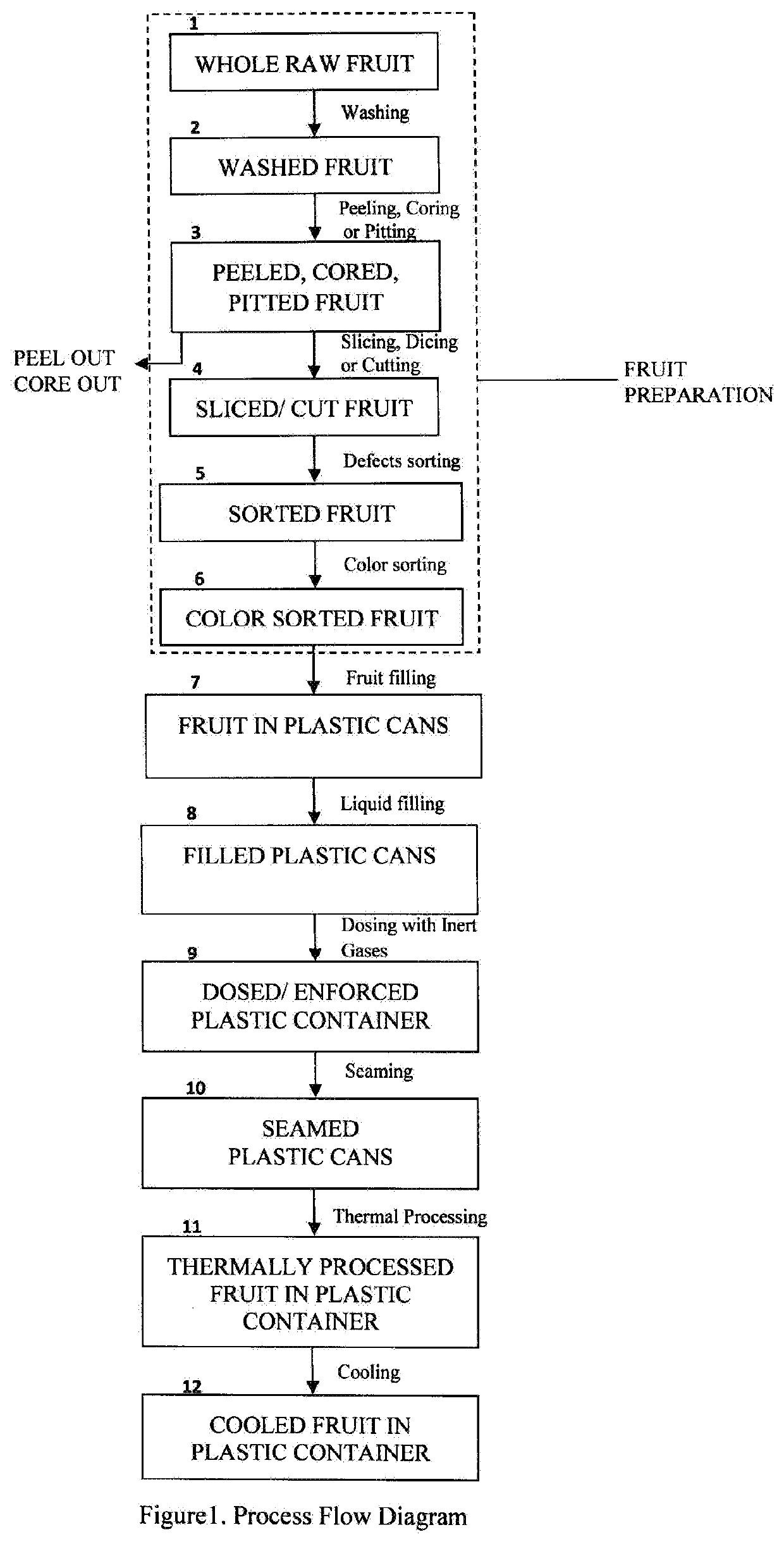Packing fruits in plastic cans
a technology of plastic cans and fruits, applied in the field of preserving and packaging fruits, can solve the problems of creating negative pressure within the container, too much headspace, etc., and achieve the effects of preserving product integrity, reducing headspace/air in the package, and reducing the tolerance to changes in pressur
- Summary
- Abstract
- Description
- Claims
- Application Information
AI Technical Summary
Benefits of technology
Problems solved by technology
Method used
Image
Examples
example 1
[0030]The fresh pineapple fruit is washed with water, graded, inspected for foreign objectionable materials, peeled, cored, sliced and or cut into pieces, and sorted for defects and color. The pineapple pieces are then filled into pre-washed empty plastic can containers at about 255 grams fill weight. The fruit-filled plastic cans are topped with packing medium composed of pineapple juice with ascorbic acid and citric acid. The package is comprised of around 60% pineapple and 40% pineapple juice mixture.
[0031]As shown in table below, about 255 grams of pineapple pieces is filled into the plastic cans and topped with around 170 grams of pineapple juice mixture.
Pack Fill IngredientsWeight (gr)Weight %Pineapple255.060.00Pineapple Juice169.339.83Ascorbic acid0.50.12Citric acid0.20.05Total425.0100.00
[0032]At this package composition, a target headspace of 5.0 mm is achieved. Fill weight and headspace parameters should, be controlled to avoid container deformation due to thermal expansion...
example 2
[0036]Peaches are washed with water, peeled, pitted, cut into dices and sorted for defects and color. A 856 grams package contains around 69 to 31 percent fruit to liquid ratio. As shown in the table below, about 591 grams of diced peaches is filled into clean plastic cans.
Pack Fill IngredientsWeight (gr)Weight %Peaches591.069.04Water225.126.30Sugar38.74.52Ascorbic acid0.70.08Citric acid0.50.06Total856.0100.00
[0037]A mixture of water, sugar, and ascorbic acid as liquid packing medium is previously prepared and heated. The sugar is added in the solution in amounts to achieve a ° Brix of 15.0. Citric acid is added to keep pH within 3.0 to 3.9 while Ascorbic acid is added to protect color and flavor.
[0038]The fruit-filled plastic cans are topped with the heated liquid packing medium at a filling temperature of 70° C. to 90° C. and dosed with nitrogen gas at around 10.0 psi. These cans are then seamed with metal can ends. Visual inspection of the seamed sample cans should have a seam th...
example 3
[0040]Fresh batch of raspberries are washed and stems are removed. The washed fruits are sorted for defects and color.
[0041]For a product with a 68% to 32% fruit to liquid ratio, 289.0 grams of sorted raspberries are weighed and then filled into each clean plastic can.
Pack Fill IngredientsWeight (gr)Weight %Raspberries289.068.00Water96.322.66Sugar38.49.04Citric acid0.90.21Ascorbic acid0.40.09Total425.0100.00
[0042]Around 136.0 grams of a mixture of water, sugar, citric acid and ascorbic acid is prepared and heated as liquid packing medium. The liquid packing medium has a ° Brix of around 29.0° B. Around 38.4 grams of sugar is added to achieve the target finished product Brix. The liquid is also acidified with around 0.9 grams of citric acid to keep pH less than 4.0. Ascorbic acid of about 0.4 grams is also added as antioxidant.
[0043]The heated liquid is filled into the plastic cans at a filling temperature of 60° C. to 85° C. The filled cans are dosed with carbon dioxide at a pressur...
PUM
| Property | Measurement | Unit |
|---|---|---|
| Temperature | aaaaa | aaaaa |
| Temperature | aaaaa | aaaaa |
| Temperature | aaaaa | aaaaa |
Abstract
Description
Claims
Application Information
 Login to View More
Login to View More - R&D
- Intellectual Property
- Life Sciences
- Materials
- Tech Scout
- Unparalleled Data Quality
- Higher Quality Content
- 60% Fewer Hallucinations
Browse by: Latest US Patents, China's latest patents, Technical Efficacy Thesaurus, Application Domain, Technology Topic, Popular Technical Reports.
© 2025 PatSnap. All rights reserved.Legal|Privacy policy|Modern Slavery Act Transparency Statement|Sitemap|About US| Contact US: help@patsnap.com

